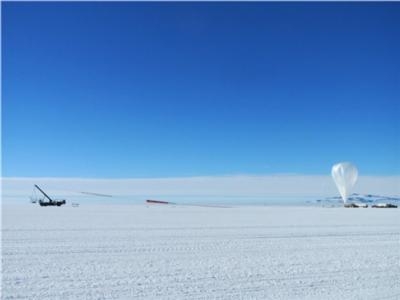Keeps Balloons Over Antarctic Landmass For Extended Periods Of Time
While winter is closing in on the northern hemisphere, it’s nearing summertime in Antarctica, which for NASA’s Scientific Balloon Program means one thing: anticyclone.

An anticyclone is a weather phenomena characterized by high atmospheric pressure at its center, around which air slowly circulates in a counterclockwise pattern in the southern hemisphere (clockwise in the northern hemisphere).
Each year, the agency’s globetrotting balloon team dons parkas and mukluks for their annual flight campaign in Antarctica, and the anticyclone that forms there is particularly helpful for conducting scientific investigations.
“The anticyclone takes our balloons on a circular flight trajectory, keeping the balloon over the Antarctic land mass for extended periods of time,” said Debbie Fairbrother, NASA’s Balloon Program Office chief. “Keeping the balloon over land helps enable recovery of the payload at the conclusion of the mission.”
Campaign preparations began on-site at McMurdo Station, Antarctica, in mid-October for the two science missions NASA has scheduled to fly from the continent. The balloon launch team is standing by flight ready and approved for launch, pending the formation of the anticyclone, which is expected by mid-December.
The two flights planned will take the Gamma-Ray Imager/Polarimeter for Solar flares (GRIPS) and the Stratospheric Terahertz Observatory (STO-II) payloads to altitudes around 130,000 feet, which is above more than 99.5 percent of the Earth’s atmosphere.
GRIPS is an instrument that will collect data on the extremely high-energy particles released by solar flares, information that will help scientists pinpoint the processes that set off these explosive events. The mission is funded by the NASA Low Cost Access to Space (LCAS) program, now part of Heliophyics Technology and Instrument Development for Science (H-TIDeS) program
STO-II is a NASA-funded experiment designed to address a key problem in modern astrophysics: understanding the life cycle of the interstellar medium, which is the matter that fills the space between stars in the galaxy. STO-II’s instruments will collect data by performing large-scale, high resolution spectroscopic galactic surveys. These surveys will cover a portion of the galactic plane as well as a deeper survey of galactic arm and inter-arm regions.
The payloads and instruments are solar-powered, making this time of year an ideal time to for balloon flights since the region experiences sunlight 24-hours a day during the Antarctic summer. Each science payloads weigh around 3,500 pounds. Including the gondola, ballast and weight of the balloon, the total load lifted by the massive heavy-lift balloons for each mission is around 9,600 pounds. NASA’s is using its largest qualified zero pressure balloon for each flight, which at 40-million-cubic-feet of volume is as large as a football stadium when fully inflated.
“From the austere environment to time away from family during the holidays, the team endures a lot during this annual campaign,” said Fairbrother. “We all wish the team well on the ice as they work the exciting science missions flying this year.”
(Image provided with NASA news release)
 Bolen Gives Congress a Rare Thumbs-Up
Bolen Gives Congress a Rare Thumbs-Up The SportPlane Resource Guide RETURNS!!!!
The SportPlane Resource Guide RETURNS!!!! Buying Sprees Continue: Textron eAviation Takes On Amazilia Aerospace
Buying Sprees Continue: Textron eAviation Takes On Amazilia Aerospace Hawker 4000 Bizjets Gain Nav System, Data Link STC
Hawker 4000 Bizjets Gain Nav System, Data Link STC Echodyne Gets BVLOS Waiver for AiRanger Aircraft
Echodyne Gets BVLOS Waiver for AiRanger Aircraft



